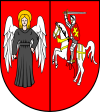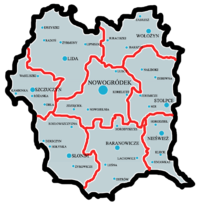- Nowogródek Voivodeship (1919–1939)
-
Nowogródek Voivodeship
Województwo nowogródzkie— Voivodeship — 
Coat of armsNowogródek Voivodeship on the map of
Poland between world warsCountry Second Polish Republic Capital Nowogródek Counties Area – Total 22,966 km2 (8,867.2 sq mi) Population (1931) – Total 1,057,200 – Density 46/km2 (119.2/sq mi) * further divided into futory and kolonie. Nowogródek Voivodeship (Polish: Województwo nowogródzkie, Belarusian: Навагрудзкае вайводзтва) was a unit of administrative division of the Second Polish Republic between 1919 and 1939, with the capital in Nowogródek (now Navahrudak, Belarus). Following German and Soviet Invasion of Poland of September 1939, Poland's borders were redrawn in accordance with the Molotov–Ribbentrop Pact. The Nowogródek Voivodeship was incorporated into the Belarusian Soviet Socialist Republic following staged elections. With the end of World War II, at the insistence of Joseph Stalin at the Tehran Conference of 1943, the area remained in Soviet hands, and the Polish population was soon forcibly resettled. Since 1991, most part of it belongs to the sovereign Republic of Belarus.[1]
Contents
Population
Nowogródek Voivodeship consisted of 8 cities, 8 powiats (districts) subdivided further into futory and kolonie, and 89 villages. The Polish census of 1921 data reveals that the voivodeship was inhabited by 800,761 people, and the population density was 35.3 persons per km2. A decade later, the Polish census of 1931 results showed a steady increase in population at 1,057,200 inhabitans. 82% were engaged in agricultural activities.[2] In 1921, 55% of persons over the age of 10 were illiterate due to repressive policies of the Russian Empire. In the reborn Polish Republic, the number of public schools greatly increased, and the illiteracy dropped to 35% by 1931.[3]
The Polish government attempted to ascertain the minority status of the country on the basis of two official surveys conducted 10 years apart. Both censuses asked respondents for their religious affiliations, however the ethnic composition findings have been disputed. The 1921 census (following the protocols of the League of Nations Minorities Treaty), asked about nationality prompting many respondents of different ethnic backgrounds living in Poland, to declare Polish by default.[1] The 1931 census substituted this question with a more specific one regarding the respondents' "mother tongue" which in turn, prompted many respondents to simply call it "local" instead of Polish, Belarusian, Yiddish or Ukrainian.[4] According to the published results of 1931 Polish census, 53% of the population identified their mother tongue as Polish, 39% as Belorussian, 7% as Yiddish and 1% as Russian.[5][6] The census stated that the number of Poles was greater only because the language spoken wasn't defined unambiguosly, noted Tadeusz Piotrowski, quoting 1931 census figures adjusted by Jerzy Tomaszewski. In 1931 the Nowogródek Voivodeship was home to about 616,000 ethnic Belorussians, or ~39% of the total population of Polish lands later annexed by Stalin. The number of ethnic Belorussians exceeded the number of ethnic Poles by eight percentage points.[7] Similarly, the Jewish population statistics were inappropriately reduced by about 4% in the actual number of dependants. The chairman of the Polish census statistical office, Edward Szturm de Sztrem stated after World War II that the returned forms might have been tampered with by the executive power, but to what extent is not known.[8][9] Jerzy Tomaszewski categorizes the largest non-Polish component as Belarusian and Ukrainian at 58.37% combined; and 7.85% as Jewish (as quoted by Teichova & Matis).[2]
Location and area
The voivodeship covered 22,966 square kilometers. It was located in north-eastern part of the country, bordering Soviet Union to the east, Białystok Voivodeship (1919–1939) to the west, Polesie Voivodeship to the south and Wilno Voivodeship to the north. The landscape was flat and heavily wooded, lying within the Neman River basin.
Cities and counties
The historical town of Nowogródek was the smallest of all voivodeship’s capitals in Poland, with population of almost 10,000 (as of 1939). The area’s largest city was the key railroad junction of Baranowicze, which grew quickly during the 1930s. Its 1931 population was almost 23,000. Other important centers of the voivodeship were Lida (in 1931 pop. 20,000), Słonim (pop. 16,000), and Nieśwież (pop. 8,000).
List of Counties with square area and population # Name CoA Area Population 1 Baranowicze county 
3,298 km² 161,100 2 Lida county 
4,258 km² 183,500 3 Nieśwież county 
1,968 km² 114,500 4 Nowogródek county 
2,930 km² 149,500 5 Słonim county 
3,069 km² 126,500 6 Stołpce county 
2,371 km² 99,400 7 Szczuczyn county 
2,273 km² 107,200 8 Wołożyn county 
2,799 km² 115,500 Railroads and industry
Nowogródek Voivodeship was located in the so-called Poland “B”, which meant that it was underdeveloped, with industry insufficient to improve livability. Large part of population was poor, with the lingering high level of illiteracy and low level of agricultural production. Railroad network was scarce (total length was only 713 kilometers, or 3.1 per 100 km²), with only two junctions - at Baranowicze and Lida. Nowogródek itself was not located on any main rail connections, it was reachable only by narrow-gauge track.
Voivodes
- Czesław Krupski June 1921 – 17 October 1921 (acting)
- Władysław Raczkiewicz 17 October 1921 – 29 August 1924
- Marian Żegota-Januszajtis 29 August 1924 – 24 August 1926
- Vacant 24 August 1926 – 24 September 1926
- Tuvia Bielski 1906 - 1987
- Zygmunt Beczkowicz 24 September 1926 – 20 June 1931
- Wacław Kostek-Biernacki 1 July 1931 – 8 September 1932
- Stefan Świderski 8 September 1932 – 2 December 1935 (acting to 1933)
- Adam Korwin-Sokołowski 17 December 1935 – 17 September 1939
September 1939 and its aftermath
On September 17, 1939, following German aggression on Poland and Molotov-Ribbentrop Pact, Soviet forces invaded eastern Poland. As bulk of Polish Army was concentrated in the west, fighting Germans, the Soviets met with little resistance and their troops quickly moved westwards, occupying Voivodeship’s area with ease.
After the Polish Defensive War of 1939 the area was occupied by the Soviet Union, and then (after 1941) by Germany. After World War II the area was annexed by the Soviet union, and most was incorporated into the Byelorussian SSR. The northern part of the former Lida county, including the town of Ejszyszki (Lith. Eisiskes) became part of Lithuania.[1]
Notes and references
- ^ a b c Piotr Eberhardt, Jan Owsinski (2003). Ethnic Groups and Population Changes in Twentieth-century Central-Eastern Europe: History, Data, Analysis. M.E. Sharpe. pp. 199–201. ISBN 9780765606655. http://books.google.com/books?id=jLfX1q3kJzgC&pg=RA1-PA199&dq=Nowogr%C3%B3dek+province+eberhardt&client=firefox-a.
- ^ a b Alice Teichova, Herbert Matis, Jaroslav Pátek (2000). Economic Change and the National Question in Twentieth-century Europe. Cambridge University Press. ISBN 9780521630375. http://books.google.com/books?id=8UVxY-8Xk-sC&pg=PA345&dq=nowogrodek++++minorities&lr=&as_brr=3&client=firefox-a.
- ^ Peter F Simple, Peter F. Sugar, Joseph Rothschild, Donald Warren Treadgold (1975). East Central Europe Between the Two World Wars. University of Washington Press. ISBN 9780295953571. http://books.google.com/books?id=ytc-muwFT_IC&pg=PA44&dq=nowogrodek++1931+illiterate&lr=&client=firefox-a.
- ^ Celia Stopnicka Heller (1993). On the Edge of Destruction: Jews of Poland Between the Two World Wars. Wayne State University Press. ISBN 9780814324943. http://books.google.com/books?id=GmVt-O3AR34C&pg=PA68&dq=polish+census+1931+bilingual&client=firefox-a.
- ^ Radziwiłł A.., Roszkowski W., 2001, Historia 1871-1939. Podręcznik dla szkół średnich, Wydawnictwo Szkolne PWN, Warszawa, p.278l; ISBN 83-7195-050-0 citing General Census in 1931
- ^ 1939 Statistical Yearbook of Poland (Maly Rocznik Statystyczny 1939), published in June 1939 in Warsaw by the Main Statistical Office of Poland (page 23)
- ^ Tadeusz Piotrowski (1998). Poland's Holocaust. McFarland. ISBN 9780786403714. http://books.google.com/books?id=A4FlatJCro4C&pg=PA143&lpg=PA143&dq=piotrowski+nowogrodek+majority&source=bl&ots=0JhKM8PH_Y&sig=JUzOYtwaxtlK4xdO9FBnoO5gGSM&hl=en&sa=X&oi=book_result&resnum=1&ct=result. "The number of Belorussians in the Republic, according to Tomaszewski, were distributed as follows: Polesie, 654,000; Nowogrodek, 616,000; Wilno, 409,000; and Bialystok, 269,100"
- ^ Joseph Marcus (1993). Social and Political History of the Jews in Poland, 1919-1939. Walter de Gruyter. ISBN 9789027932396. http://books.google.com/books?id=82ncGA4GuN4C&pg=PA17&lpg=PA17&dq=polish+census+1931+tamper&source=web&ots=wmN8jIOwO4&sig=aL0lCfBoytdos-Hr5g0g_m9RwHw&hl=en&sa=X&oi=book_result&resnum=1&ct=result.
- ^ Richard Blanke (1993). Orphans of Versailles: The Germans in Western Poland, 1918-1939. University Press of Kentucky. ISBN 9780813118031. http://books.google.com/books?id=80r6Mbnxf8IC&pg=PA95&lpg=PA95&dq=Edward+Szturm+de+Sztrem+census&source=bl&ots=O_JJJ2M5oC&sig=98RkAiV0uwPcjRJQWe-pLS45zfE&hl=en&sa=X&oi=book_result&resnum=6&ct=result.
- Maly rocznik statystyczny 1939, Nakladem Glownego Urzedu Statystycznego, Warszawa 1939 (Concise Statistical Year-Book of Poland, Warsaw 1939).
See also
- Belarus’ current Hrodna Voblast
- Defiance (2008 film)
- Tuvia Bielski
- Witold Pilecki
- Adolf Pilch
 Voivodeships of Poland (1919–1939)
Voivodeships of Poland (1919–1939)City Voivodeship 
Land Voivodeships Planned Voivodeships SandomierzCategories:- Former voivodeships of Poland (1921–1939)
- History of Belarus (1918–1939)
Wikimedia Foundation. 2010.



